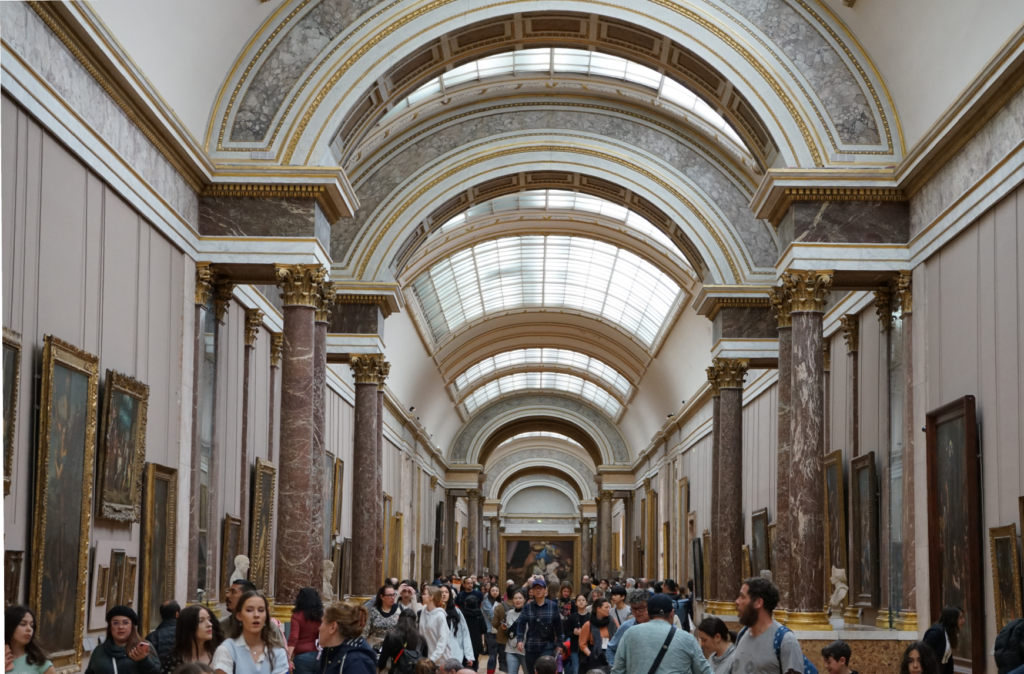
Keen to avoid the ticket queues outside Paris’ Louvre Museum, Vicki and I thought we’d be smart about it and pre-book online. The Louvre website informed us, however, that due to a technical issue online booking was unavailable, so we resigned ourselves to just turn up the next day and take our place in line.
Jumping off the train at the Palais Royal – Musée du Louvre metro station, we joined the throng surging towards the exit. I’d heard many things about the world famous Museum, but mostly that it’s massive, the crowds are too, and the Mona Lisa is not. Walking through the arched passage into the Louvre’s courtyard I discovered that the first two are undoubtedly true.
There was a mass of people moving slowly through a cordoned race, and disappearing into the incongruous glass pyramid that serves as the Louvre’s entry. A separate line of people, that didn’t seem to be moving at all, stretched way down the courtyard’s southern wall. In front of these two enormous queues was a large group of people who looked lost and confused; brows furrowed, mouths slightly open. We joined them.
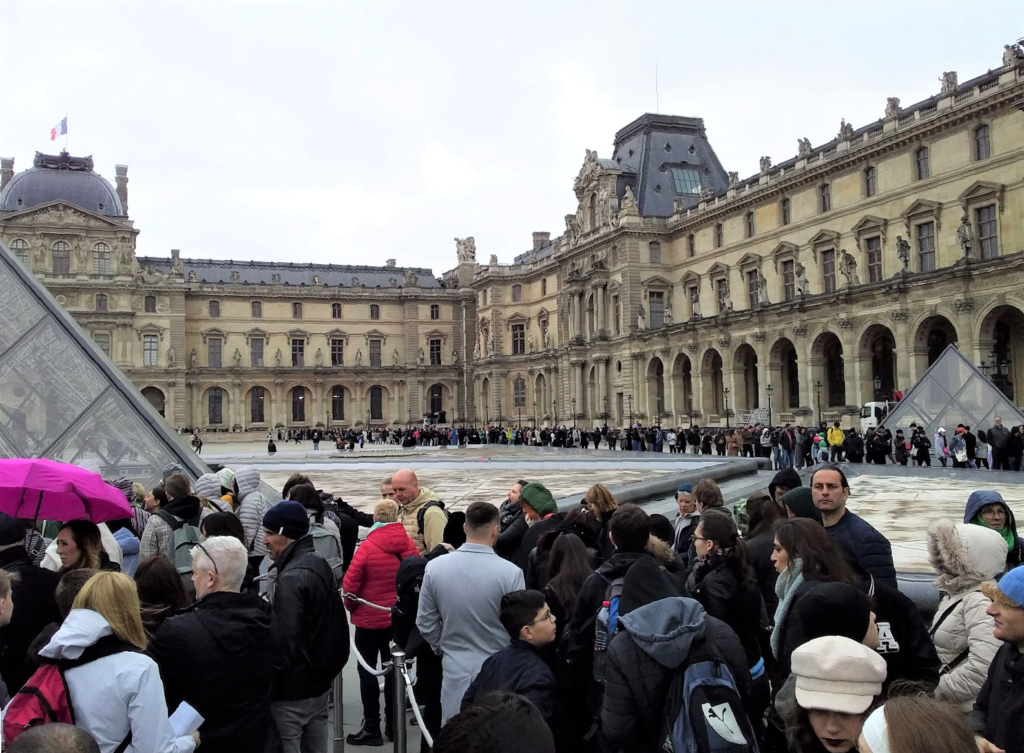
After a bit of bewildered standing and gaping of our own, we found a staffer to ask for help. He suggested we buy tickets online – presumably the booking system was back up and running – rather than joining the long queue which meant over a two-hour wait. The Louvre sells time-allotted tickets, so we booked for the next intake and were soon moving surprisingly quickly through the cordoned race towards the entrance. After a sketchy start, things were on the up.
We put our bags through the security scanner and had our baguettes duly irradiated, then headed down to the Museum’s foyer. This area was teeming with people, and complete with escalators, toilets, baggage storage and cafes, reminded me a bit of a major city’s central railway station.
Vicki and I decided to go our separate ways and meet up at closing time. I spent a little while attempting to make sense of the Louvre’s visitor guide map, after which I gave up and just headed for the nearest gallery.
There are already thousands of travel guides and blogs that explain all the major attractions housed within the Louvre’s myriad galleries, but there’s much more to the Museum than just the big ticket items. So allow me to take you on a fascinating and ill-informed tour of some of the Louvre’s lesser known artworks that I found during my visit.
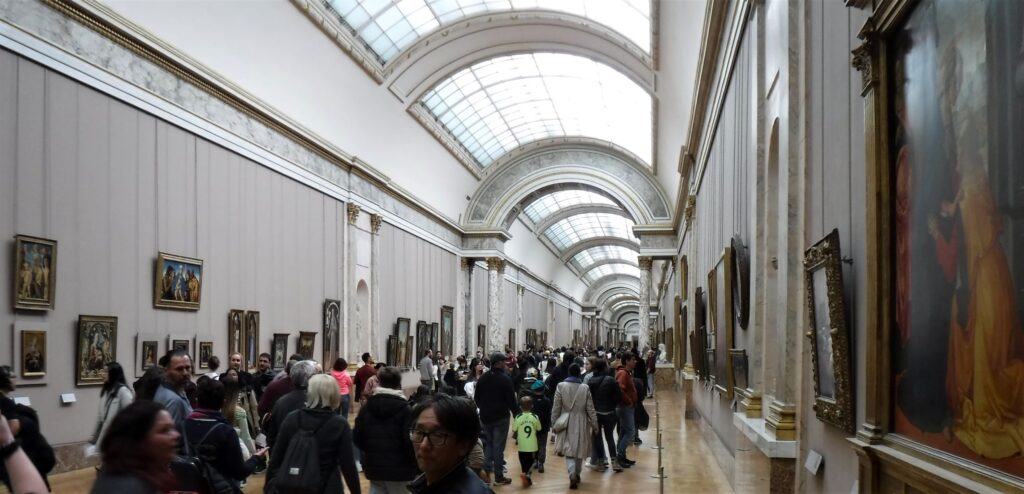
After leaving the bedlam of the foyer, I found myself in amongst the Museum’s trillion paintings, along with some of the day’s trillion other visitors. It seemded like as good a place as any to start my look around the Louvre.
Back when I was a kid, a movie would get an ‘R’ rating if it contained a three second glimpse of boob and a blood nose. These days graphic violence is everywhere in movies, tv, music videos, song lyrics, graphic novels, you name it. Although some people decry the contemporary ‘normalisation’ of violence in film and other forms of art and entertainment, it turns out it’s been around for yonks*.
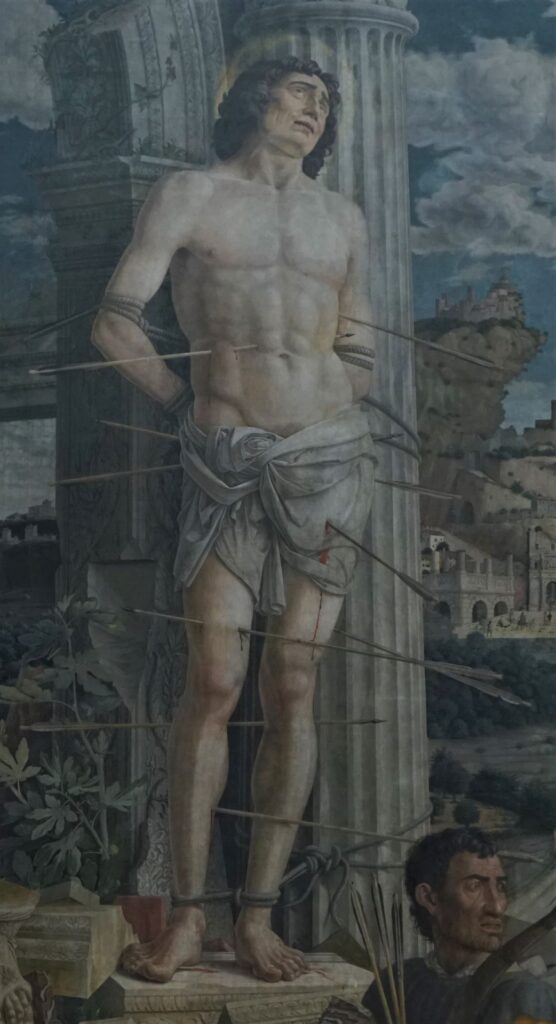
The Louvre is full of paintings of military and civilian massacres, John the Baptist’s decapitated head, and Jesus getting stabbed, crown-of-thorned and crucified over and over again. Several paintings of poor Saint Sebastian getting tortured also hang in the Museum. Persecuted for his faith, he was duly punished by being tied up and having arrows shot into him.
This is Andrea Mantegna’s circa 1480 take on the sufferings of Saint Sebastian.
‘Hey God, anytime you wanna help me out here just go right ahead…’
In amongst the carnage, sadism and mayhem, there is, of course, some lovely art depicting lovely things. In olden times, artists often created paintings of beautiful ladies, because people richer than they were (which was everybody) would buy them. The artist might also get the chance to see some hottie starkers**, or nearly so.
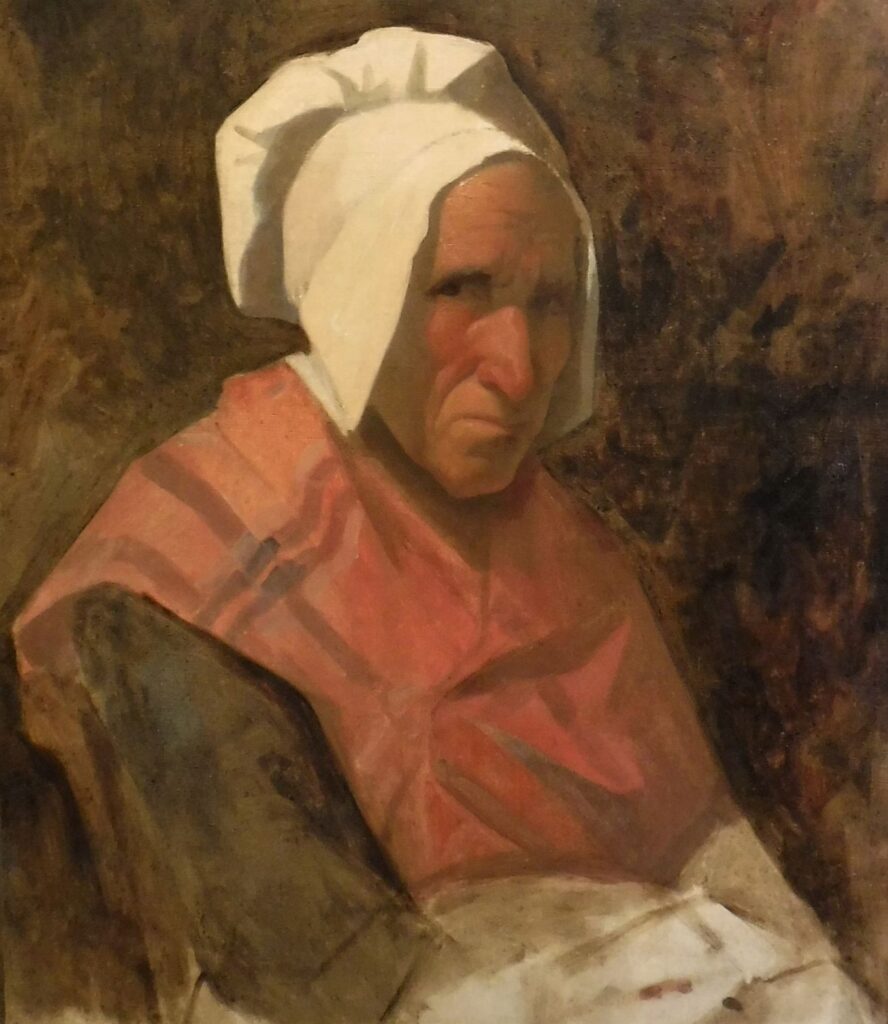
Bucking the trend, French painter Thomas Couture chose to immortalise Marie Simonet, who you couldn’t describe as classicly beautiful. Although the reason Thomas chose to paint Marie is unclear, the reason he chose to pose her fully clothed is self-explanatory.
….cripes…
In amongst its vast collection of religious paintings, the Louvre contains this interesting piece by Stefano di Giovanni, depicting the humble Franciscan Monk Ranieri Rasini. In the painting, Ranieri looks a little like something from The Jetsons, zipping down over the town to bust out a bunch of crims from the local lock-up.
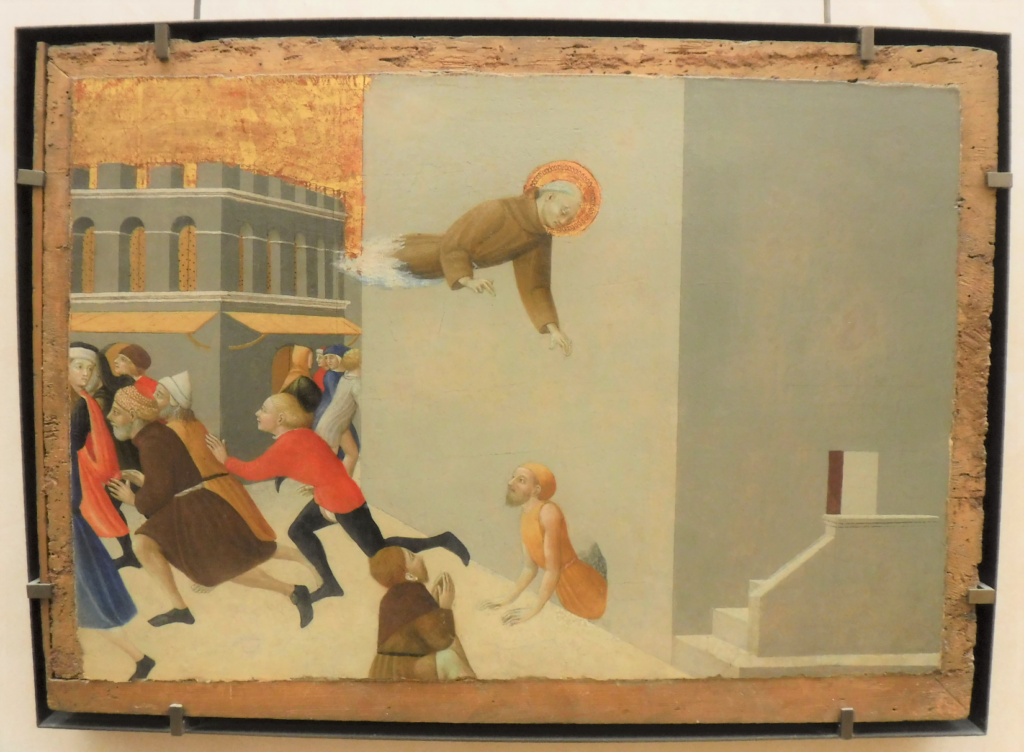
Interestingly, Friar Ranieri still went on to be sainted for his numerous miracles, despite the fact that facilitating a jailbreak is not generally considered saintly behaviour.
Over the course of European history, everyone seemed to be at war with everyone else most of the time. Through the ages, artists recorded glorious battles, great victories, military heroes, and of course the corpses of lots of dead people.
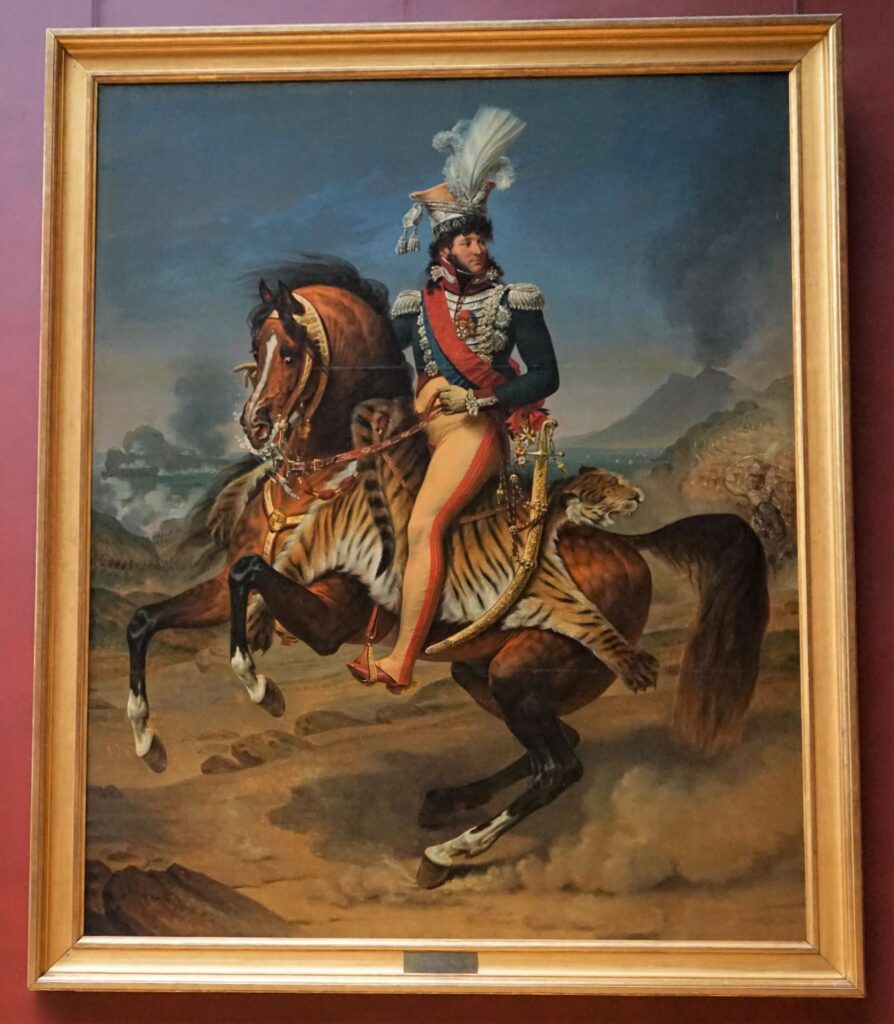
In this striking painting by Antoine Jean Gros (‘Big John’ to his mates), Joachim Murat (who was the King of Naples from 1808-15, and Napoleon’s brother-in-law), is shown on his rearing steed, wearing a nice pair of apricot jodhpurs and some serious plumage.
Joachim was always a little heavy on the brakes, and would often lock up the back hoofs
Apparently Joachim wasn’t averse to slipping a tiger over his saddle when heading to war. Although presumably being a little hard to control, having a live tiger under your backside did have its advantages. If you found yourself in a pickle during a battle, you could just stand up in your stirrups and release a wild, savage beast onto your enemy.
Theodore Gericault also painted a fine example of the French penchant for riding the tiger. In his 1812 work The Charging Chasseur, the officer has slipped Ol’ Trigger into reverse to get himself out of a dicey situation. Presumably he is also about to rise and let Tigger loose to cover his retreat.
‘Yeah back her up mate you’ve got plenty of room…’
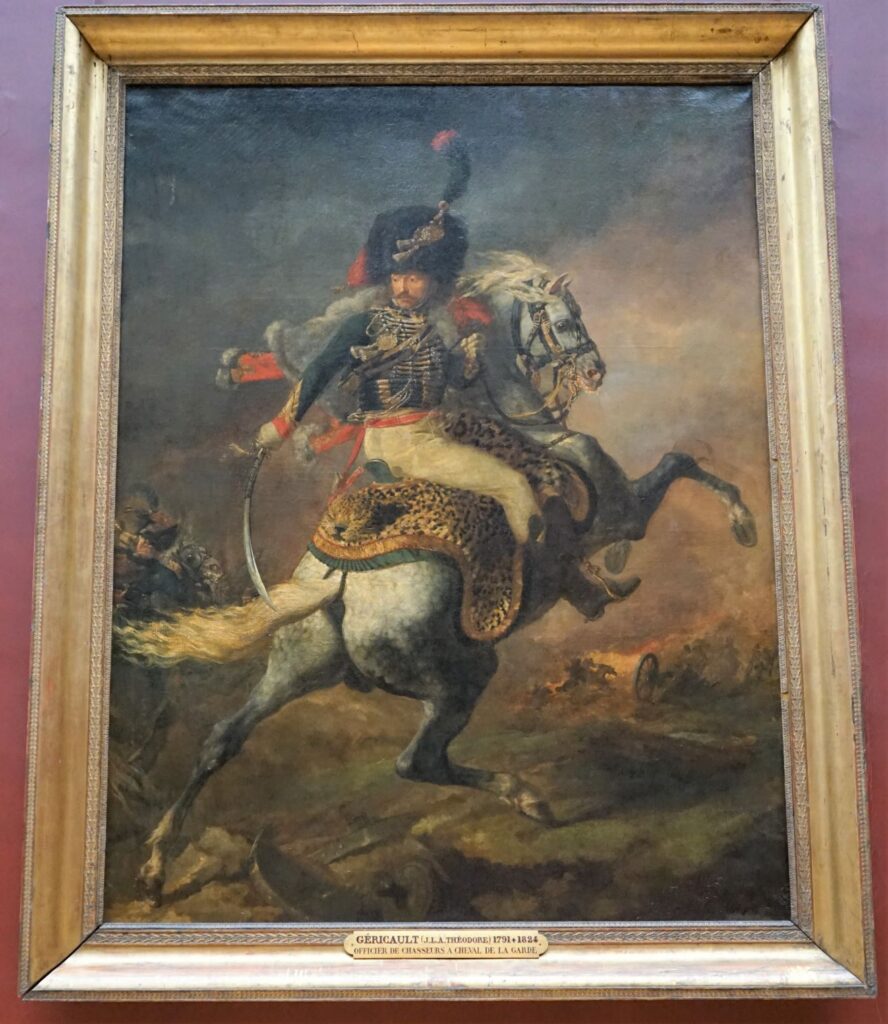
The Louvre’s enormous galleries of paintings had been crowded, and hoping for a little space, I decided to check out the Museum’s mighty collection of sculptures and carvings. It meant trying to decipher the map of the Louvre again, and around this time Vicki messaged me to see how I was getting on. I told her I was having a great time, despite having no idea where I was.
More by luck than good navigation, I eventually found my way to the sculpture galleries.
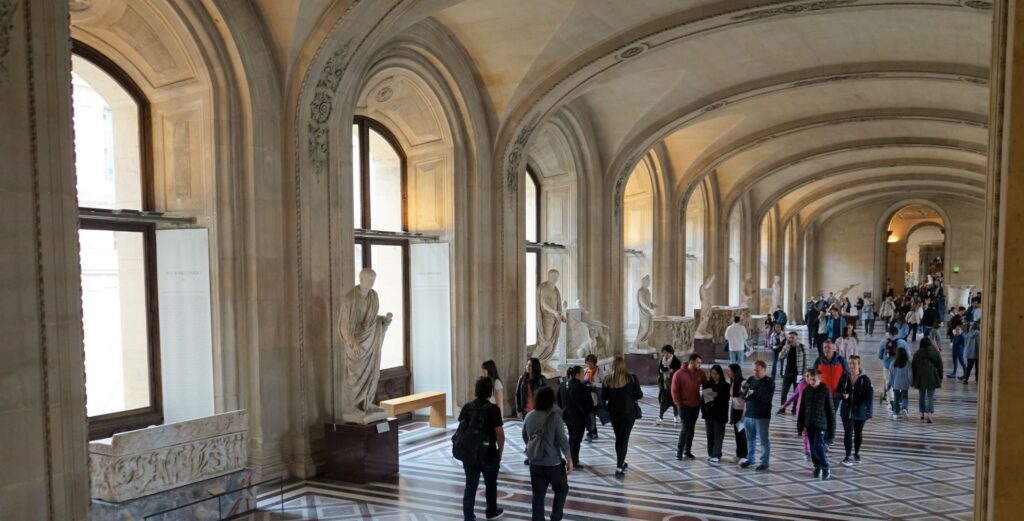
Needless to say, there was tonnes of marble on display.
‘Too many statues?’ ‘Nah mate, the house looks great.’
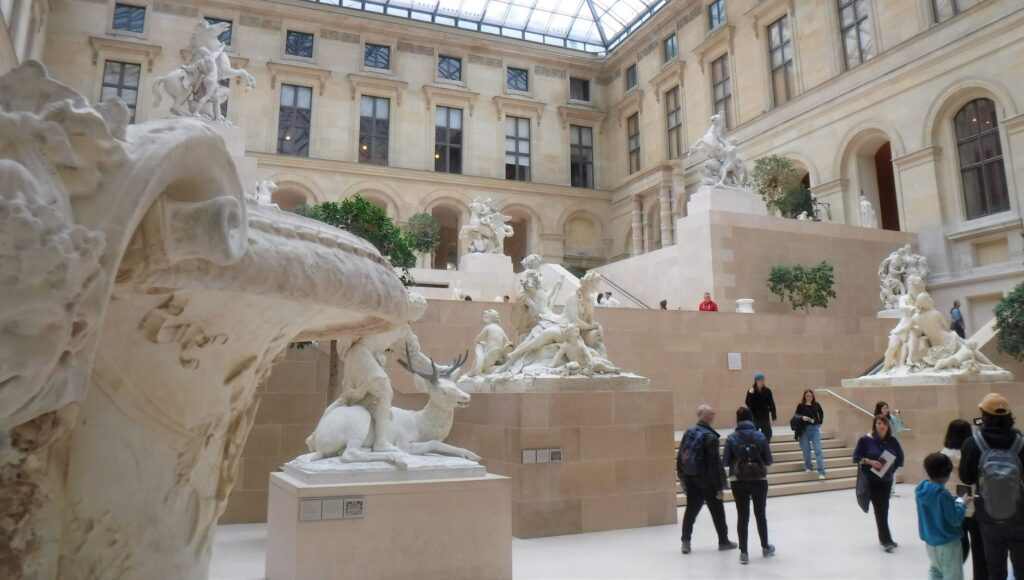
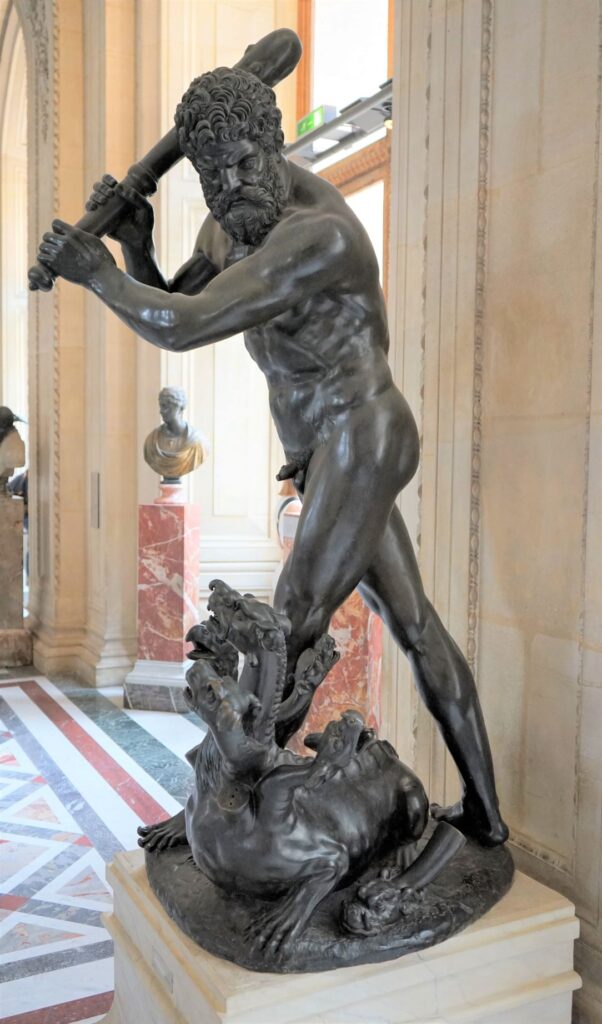
Athletic pursuits were an important part of life in ancient Rome, and the Museum had some nice examples of sport-related sculpture.
Every day’s a school day, and at the Louvre I learned that the origins of baseball actually date back to the Roman Empire. In this 16th century statue, Hercules can be seen at the plate, ready to smack one out of the Colosseum.
‘Batter up!’
Showing my ignorance, I thought the Louvre was choc-full of European art and not much else. As it happens, the Museum also has many galleries devoted to art from other parts of the world.
Groupie

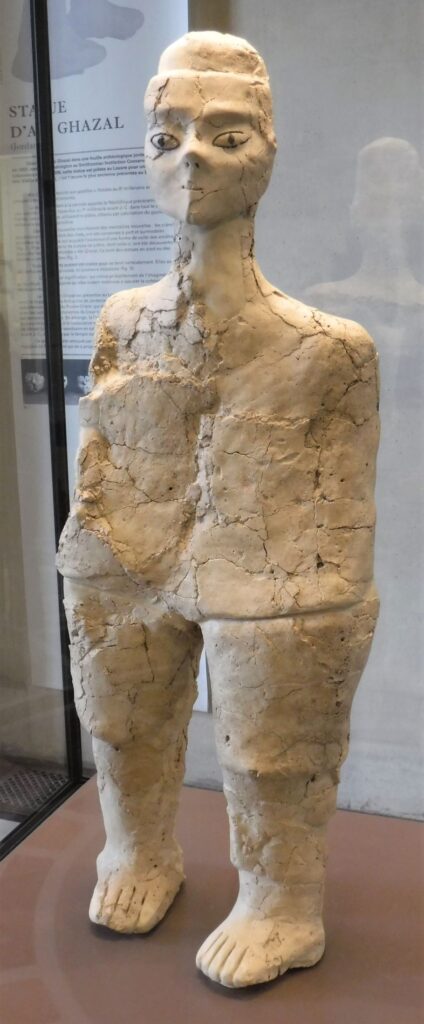
Some of the artefacts were scratched up by French archaeological teams over the years, some pieces were probably gifts from other nations, and others were probably nicked.
The oldest item in the Louvre is this plaster figure from Jordan. The Museum describes the artefact as ‘Statue de Forme Humaine‘, despite it not having any arms; appendages which are arguably necessary in order for the something to be of human form. But considering it’s 9000 years old, there’s no need to get nit-picky.
Ancient Jordanians invented the beanie
In Australia, flies can get annoying, causing Aussies to swear and snap off leafy twigs from the nearest tree to swish them away.
Well-to-do Indians took an entirely more regal approach to fly swatters, a 17th-18th century example of which I found in the Louvre. Nah, fair dinkum**, that’s really a fly swatter.
Seems a shame to use it…
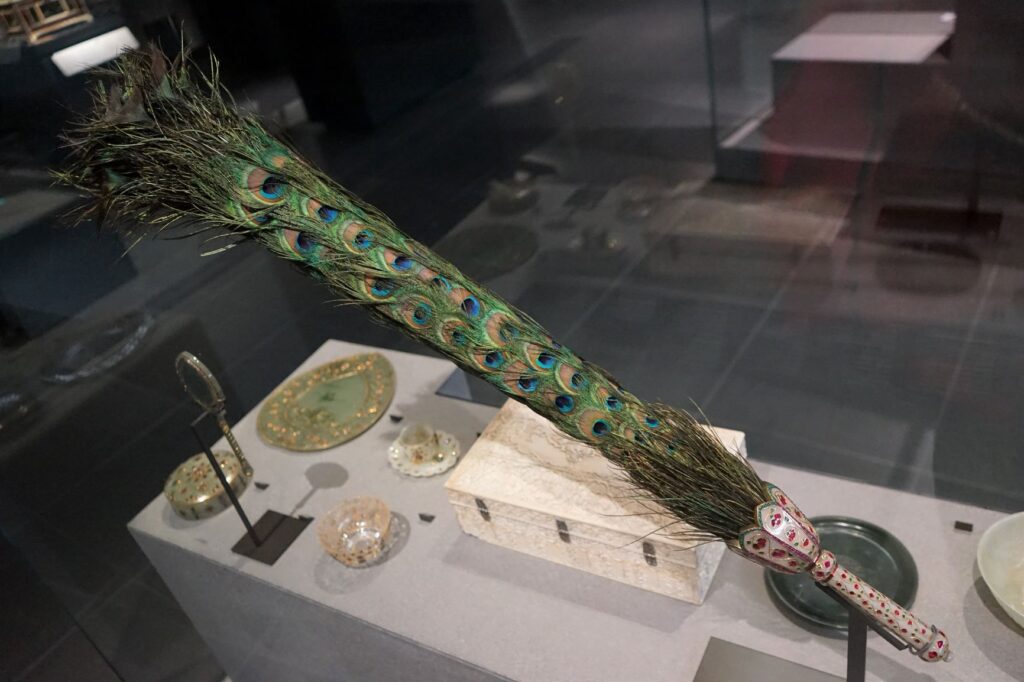
Having spent some time in Egypt, I wasn’t sure how I would feel looking at the Louvre’s Egyptian collection. Would it all seem a bit odd and out of place? Ancient artefacts from a faraway place of myth and legend now on display in central Paris? I have to say, within a few minutes of entering the first gallery I quickly forgot all about where I was; swept up once again in the beauty and mystery of ancient Egyptian art. One particularly striking piece on display was the Dendera Zodiac.
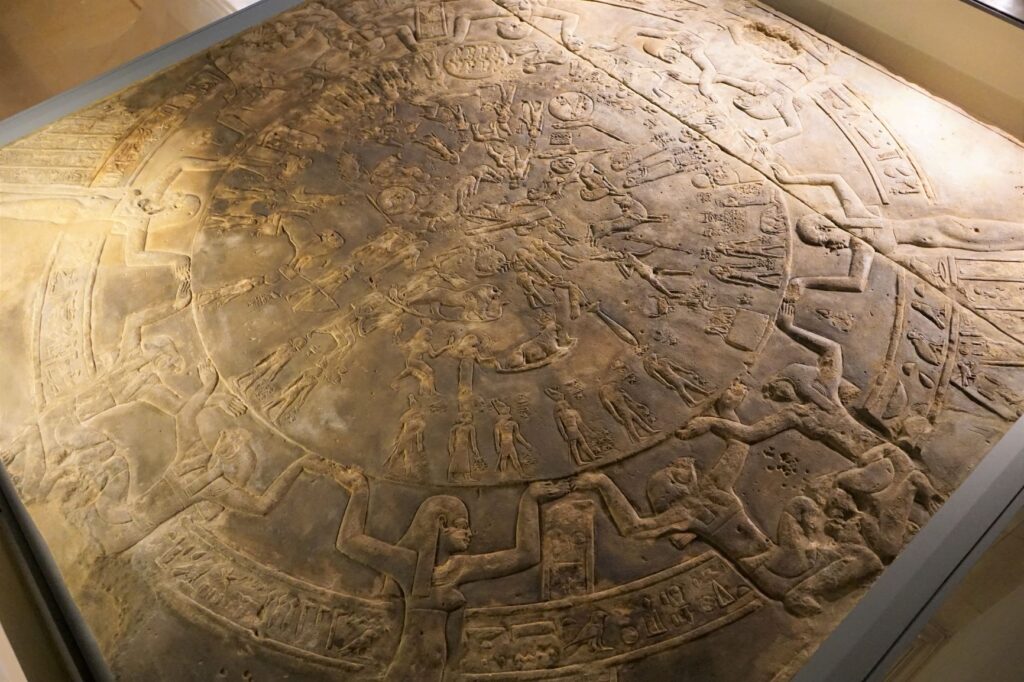
Astronomy was big in ancient Egypt, and this amazing bas-relief depicts a map of the planets and constellations complete with figures from celestial lore. Using the alignment of the planets shown in the Dendera Zodiac, researchers determined the sky depicted in the carving was observed in 50BC. The Zodiac originally resided in the ceiling of a chapel within the Dendera Temple Complex near Qena, Egypt. Apparently some art collector flogged it and shipped it off to France.
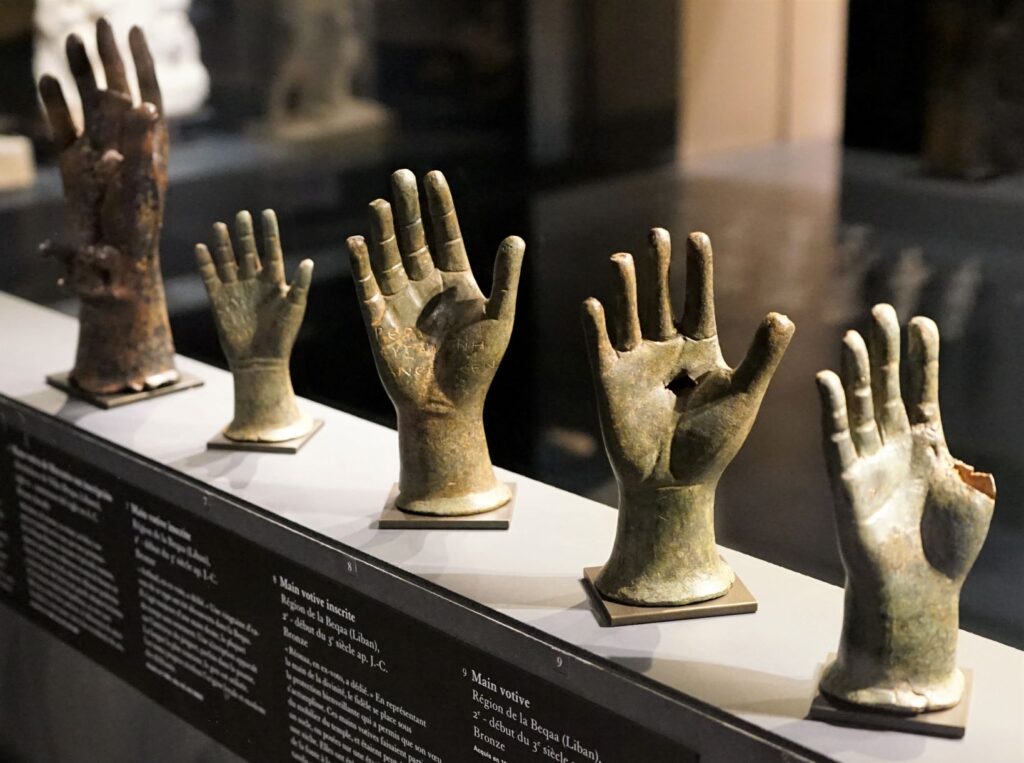
When closing time came at the Louvre, Vicki and I met up again, tired but happy after a great day exploring the Museum. We ended up returning a couple of days later to spend more time looking around the seemingly endless displays.
Whether you want to see some of the world’s most well known art, or enjoy finding some lesser known gems, the Louvre is a great place to spend a day. Or two.
Post Script
Oh, and incidentally, you know how everyone tells you that the Mona Lisa is tiny? Well, I squeezed into the packed gallery to catch a glimpse, fully expecting de Vinci’s most famous painting to be about the size of a magazine cover. Turns out she’s more than twice this size, so perhaps I was the only one in the crowd thinking the painting was bigger than I expected.
*yonks – a long time
**starkers – naked
***fair dinkum – truly, really
If you liked this post, you may also enjoy Museo Picasso, Acropolis Museum
Leave a Reply